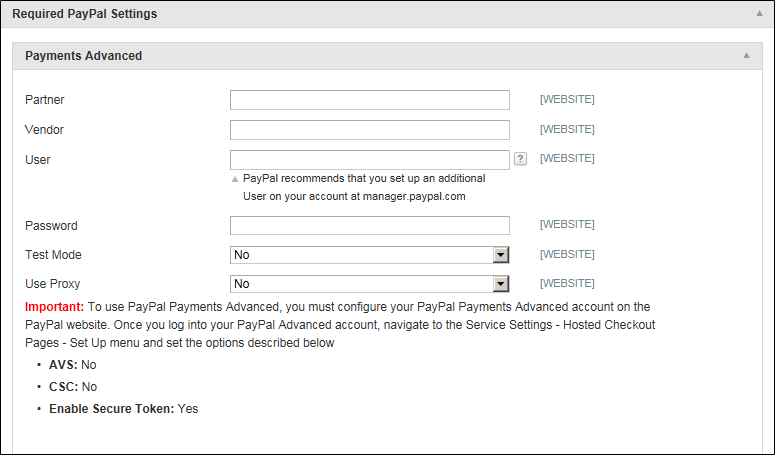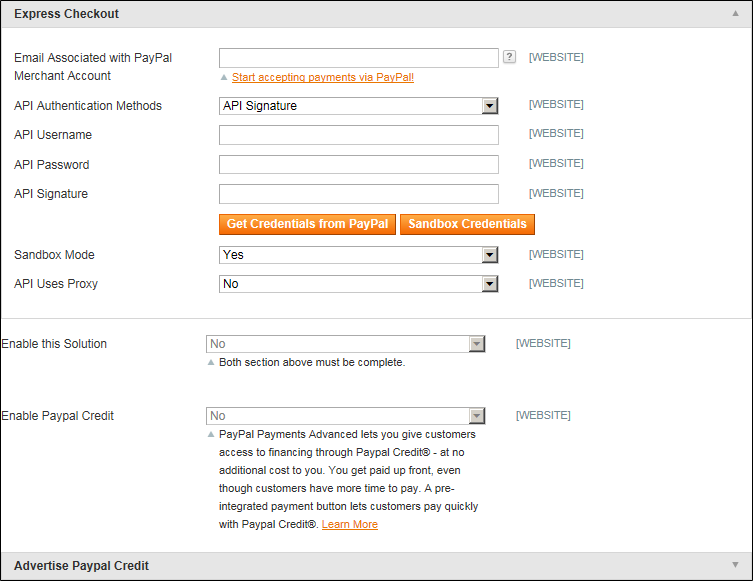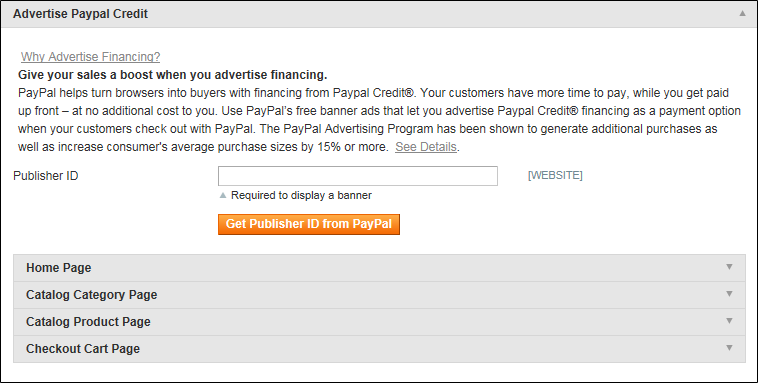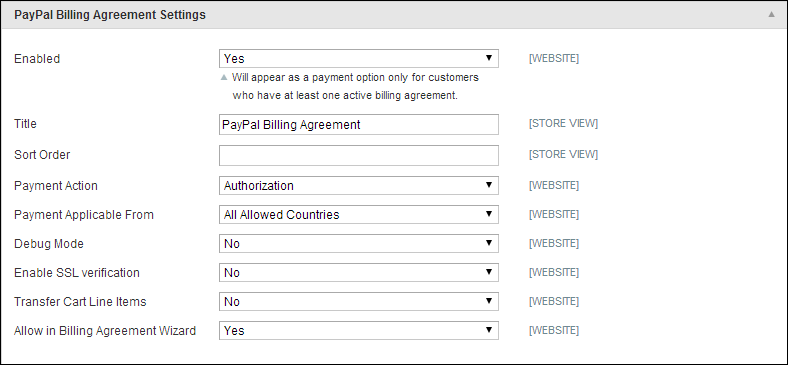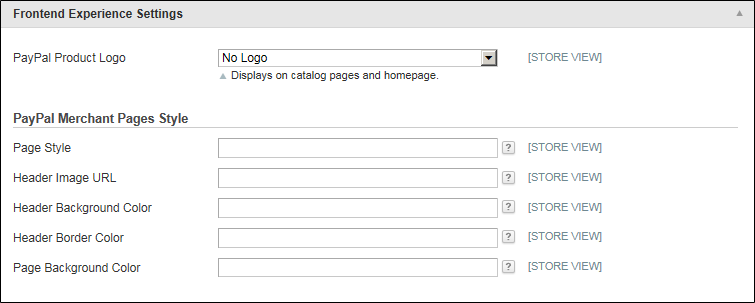Magento 1.x Security Patch Notice
For Magento Open Source 1.5 to 1.9, Magento is providing software security patches through June 2020 to ensure those sites remain secure and compliant. Visit our information page for more details about our software maintenance policy and other considerations for your business.
PayPal Payments Advanced
PayPal Payments Advanced is a PCI-compliant solution that lets your customers pay by debit or credit card without leaving your site. It includes an embedded checkout page that can be customized to create a seamless and secure checkout experience.
Even customers without a PayPal account can make purchases through PayPal’s secure payment gateway. Accepted cards include Visa, MasterCard, Switch/Maestro, and Solo credit cards in the United States and United Kingdom. For additional convenience, PayPal Express Checkout is included with PayPal Payments Advanced.
You can have two PayPal solutions active at the same time: Express Checkout, plus any All-In-One or Payment Gateway solution. If you change payment solutions, the one used previously is disabled.
With PayPal Payments Advanced, your customer stays on your site during the checkout process. The customer selects the PayPal Payments Advanced payment method on the Payment Information checkout step and clicks Continue.
The Order Review step appears, with the Pay Now button, instead of the Place Order button. After the customer clicks the Pay Now button, a PayPal-hosted form opens in the customer’s browser. The customer specifies the card information and clicks Verify Card. If the transaction is successful, the customer is redirected to the order confirmation page. The form also includes the Pay with PayPal button, which redirects the customer to the PayPal site, where payment can be made with PayPal Express Checkout.
If the transaction fails for any reason, an error message appears on the checkout page and the customer is directed to repeat the checkout process. These issue are managed by PayPal.
Processing orders with PayPal Payments Advanced is the same as processing any regular order with PayPal. An invoice, shipment, and credit memo (online/offline refund) can be created. Multiple online refunds are not available for the PayPal Payments Advanced payment method.
With PayPal Payments Advanced, an order is created in the Admin when a customer clicks the Place Order button. The order status can be any of the following, depending on the response from PayPal.
-
Processing
The transaction was successful.
Pending Payment
The system did not receive any response from PayPal.
Canceled
The transaction was not successful for some reason.
Suspected Fraud
The transaction did not pass some of the PayPal fraud filters; the system receives the response from PayPal that the transaction is under review by Fraud Service.
PayPal Payments Advanced cannot be used for orders created from the Admin of your store.
Requirements
-


If you manage multiple Magento websites, you must have a separate PayPal merchant account for each.
Setting Up PayPal Payments Advanced
| 1. | Before you begin, do the following to set up your PayPal Payments Advanced account on the PayPal website: |
| a. | Log in to your PayPal Advanced account at manager.paypal.com. |
| b. | Go to Service Settings > Hosted Checkout Pages> Set Up, and make the following settings: |
-
AVS: No CSC: No Enable Secure Token:
Yes
| c. | Save the settings. |
A separate PayPal Payments Advanced account is required for each Magento website.
| 2. | When prompted to create a layout, do the following: |
| a. | At the top of the page, click Customize. |
| b. | Select Layout C. |
| c. | Click Save and Publish. |
| 3. | PayPal recommends that you set up an additional user on your account. To set up an additional user, do the following: |
| a. | Go to manager.paypal.com and log in to your account. |
| b. | Follow the instructions to set up an additional user. |
| c. | Save the changes. |
| 1. | On the Admin menu, select System > Configuration. |
| 2. | In the panel on the left, under Sales, select Payment Methods. |
| 3. | If your Magento installation has multiple websites, stores or views, set Current Configuration Scope in the upper-left corner to the target configuration. |
| 4. | In the Merchant Location section, select the Merchant Country where your business is located. If any country other than United States is selected, the PayPal Payments Advanced settings do not appear. |
| 5. | In the PayPal All-in-One Payments Solutions section, click the Configure button for PayPal Payments Advanced. |
| 6. | Under Required PayPal Settings, in the Payments Advanced section, do the following: |
| a. | Enter one of the following credentials that you use to log in to your PayPal business account: |
-
Partner
Your PayPal Partner ID.
Vendor
Your PayPal user login name.
User
The ID of an additional user who is set up on your PayPal account.
| b. | Enter the Password that is associated with your PayPal account. |
| c. | Set Test Mode to “Yes.” |
When you are ready to “go live” with this solution, return to the configuration and set Test Mode to “No.”
| 7. | If your system uses a proxy server to establish the connection to the PayPal system, set Use Proxy to “Yes.” Then, do the following: |
| a. | Enter the IP address of the Proxy Host. |
| b. | Enter the port number of the Proxy Port. |
A proxy is used when the server firewall prevents direct access to the PayPal server. In such a case, a third-party server is used to relay traffic.
| 1. | Click to expand the Express Checkout section. Then, do the following: |
| a. | Enter the Email Address that is associated with your PayPal merchant account. |
Important! Email addresses are case sensitive. To receive payment, the email address you enter must match the email address specified in your PayPal merchant account.
| b. | Set API Authentication Methods to one of the following: |
- API Signature
- API Certificate
| c. | If necessary, click the Get Credentials from PayPal button. Then, complete the following: |
- API Username
- API Password
- API Signature or API Certificate
| d. | If you are using credentials from your sandbox account, set Sandbox Mode to “Yes.” |
If necessary, click the Sandbox Credentials button and follow the instructions to set up your testing environment.
| e. | If your system uses a proxy server to establish the connection between Magento and the PayPal payment system, set API Uses Proxy to “Yes.” Then,, complete the following: |
- Proxy Host
- Proxy Port
| 2. | When these sections are complete, set Enable this Solution to “Yes.” |
| 3. | If you would like to offer your customers financing through PayPal, set Enable PayPal Credit to “Yes.” To learn more, see: PayPal Credit. |
| 4. | To configure PayPal Credit, click to expand the Advertise PayPal Credit section. Then, do the following: |
| a. | Click the Get Publisher ID from PayPal button and follow the directions to get your account information. |
| b. | Enter your Publisher ID. |
| 5. | Click to expand the Home Page section. Then, do the following: |
| a. | To place a banner on the page, set Display to “Yes.” |
| b. | Set Position to one of the following: |
- Header (center)
- Sidebar (right)
| c. | Set Size to one of the following: |
- 190 x 100
- 234 x 60
- 300 x 50
- 468 x 60
- 728 x 90
- 800 x 66
| 6. | Repeat the previous step for the remaining sections: |
- Catalog Category Page
- Catalog Product Page
- Checkout Cart Page
| 1. | In the Basic Settings section, enter a Title to identify PayPal Payments Advanced during checkout. It is recommended that you use the title “Debit or Credit Card.” |
| 2. | If you offer multiple payment methods, enter a number in the Sort Order field to determine the sequence in which PayPal Payments Advanced appears when listed with other payment methods during checkout. |
| 3. | Set Payment Action to one of the following: |
-
Authorization Approves the purchase, but puts a hold on the funds. The amount is not withdrawn until it is “captured” by the merchant. Sale The amount of the purchase is authorized and immediately withdrawn from the customer’s account.
| 1. | At the bottom of the Basic Settings section, click to expand the Advanced Settings section. Then, complete the following as needed for your store: |
| a. | Set Payment Applicable From to one of the following: |
-
All Allowed Countries
Accepts payment from the countries already specified in your configuration.
Specific Countries
Accepts payments from only the countries you specify. Hold the Ctrl key down and in the Payment Applicable From list, click each country where you accept payment.
| b. | Set Debug Mode to “Yes” to write communications with the payment system into the log file. The log file for PayPal Payments Advanced is: payments_payflow_advanced.log. |
In accordance with PCI Data Security Standards, credit card information is not recorded in the log file.
| c. | To enable host authenticity verification, set Enable SSL verification to “Yes.” |
| d. | If you want to be able to edit the three-digit CVV security code after the customer enters it from the back of a credit card, set CVV Entry is Editable to “Yes.” |
| e. | To require that customers enter a CVV code, set Require CVV Entry to “Yes.” |
| f. | To send a confirmation of the payment to the customer, set Send Email Confirmation to “Yes.” |
| g. | If you are a developer who wants to identify the method that is used to exchange information with the PayPal server during a transaction, set the URL method for Cancel URL and Return URL to one of the following: |
-
GET
Retrieves information that is the result of a process. (This is the default method.)
POST
Provides a block of data, such as data entered into a form, to a data handling process.
The “Cancel” and “Return” URLs refer to the page where a customer returns after completing or canceling the payment part of the checkout process on the PayPal server.
| h. | To optimize the embedded checkout page for mobile devices, set Mobile Optimized to “Yes.” |
| 2. | Complete the following as needed for your store: |
A billing agreement is a sales agreement between the merchant and customer that has been authorized by PayPal for use with multiple orders. During the checkout process, the Billing Agreement payment option appears only for customers who have already entered into a billing agreement with your company. After PayPal authorizes the agreement, the payment system issues a unique reference ID to identify each order that is associated with the agreement. Similar to a purchase order, there is no limit to the number of billing agreements a customer can set up with your company.
| 1. | To make billing agreements available to your customers, click to expand the PayPal Billing Agreement Settings section. |
| 2. | Set Enabled to “Yes.” Then, do the following: |
| a. | Enter a Title to identify the PayPal Billing Agreement method during checkout. |
| b. | If you offer multiple payment methods, enter a number in the Sort Order field to determine the sequence in which Billing Agreement appears when listed with other payment methods during checkout. |
| c. | Set Payment Action to one of the following: |
-
Authorization Approves the purchase, but puts a hold on the funds. The amount is not withdrawn until it is “captured” by the merchant. Sale The amount of the purchase is authorized and immediately withdrawn from the customer’s account.
| d. | Set Payment Applicable From to one of the following: |
-
All Allowed Countries
Accepts payment from the countries already specified in your configuration.
Specific Countries
Accepts payments from only the countries you specify. Hold the Ctrl key down and in the Payment Applicable From list, click each country where you accept payment.
| e. | To record communications with the payment system in the log file, set Debug Mode to “Yes.” |
The log file is stored on the server and is accessible only to developers. In accordance with PCI Data Security Standards, credit card information is not recorded in the log file.
| f. | To enable SSL verification, set Enable SSL verification to “Yes.” |
| g. | To display a summary of each line item in the customer’s order on your PayPal payments page, set Transfer Cart Line Items to “Yes.” |
| h. | To allow customers to initiate a billing agreement from the dashboard of their customer account, set Allow in Billing Agreement Wizard to “Yes.” |
| 1. | Click to expand the Settlement Report Settings section. |
| 2. | If you have signed up for PayPal’s Secure FTP Server, enter the following SFTP login credentials: |
- Login
- Password
| 3. | To run test reports before “going live” with Express Checkout on your site, set Sandbox Mode to “Yes.” |
| 4. | Enter the Custom Endpoint Hostname or IP Address. By default, the value is: reports.paypal.com |
| 5. | Enter the Custom Path where reports are saved. By default, the value is: /ppreports/outgoing |
| 6. | To generate reports according to a schedule, under Scheduled Fetching, make the following settings: |
| a. | Set Enable Automatic Fetching to “Yes.” |
| b. | Set Schedule to one of the following: |
- Daily
- Every 3 Days
- Every 7 Days
- Every 10 Days
- Every 14 Days
- Every 30 Days
- Every 40 Days
PayPal retains each report for forty-five days.
| c. | Set Time of Day to the hour, minute, and second when you want the reports to be generated. |
The frontend experience settings give you the opportunity to choose which PayPal logos appear on your site, and to customize the appearance of your PayPal merchant pages.
| 1. | Click to expand the Frontend Experience Settings section. |
| 2. | Select the PayPal Product Logo that you want to appear in the PayPal block in your store. The PayPal logos are available in four styles and two sizes. Options include: |
- No Logo
- We Prefer PayPal (150 x 60 or 150 x 40)
- Now Accepting PayPal (150 x 60 or 150 x 40)
- Payments by PayPal (150 x 60 or 150 x 40)
- Shop Now Using (150 x 60 or 150 x 40)
| 3. | To customize the appearance of your PayPal merchant pages, do the following: |
| a. | Enter the name of the Page Style that you want to apply to your PayPal merchant pages. Options include: |
-
paypal
Uses the PayPal page style.
primary
Uses the page style that you identified as the “primary” style in your account profile.
your_custom_value
Uses a custom payment page style, which is specified in your account profile.
| b. | In the Header Image URL field, enter the URL of the image that you want to appear in the upper-left corner of the payment page. The maximum file size is 750 pixels wide by 90 pixels high. |
PayPal recommends that the image be located on a secure (https) server. Otherwise, the customer’s browser may warn that “the page contains both secure and nonsecure items.”
| c. | Enter the six-character hexadecimal code, without the “#” symbol, for each of the following: |
-
Header Background Color Background color for the checkout page header
Header Border Color 2-pixel border around the header.
Page Background Color Background color for the checkout page and around the header and payment form.
| 3. | When complete, click the Save Config button. |



